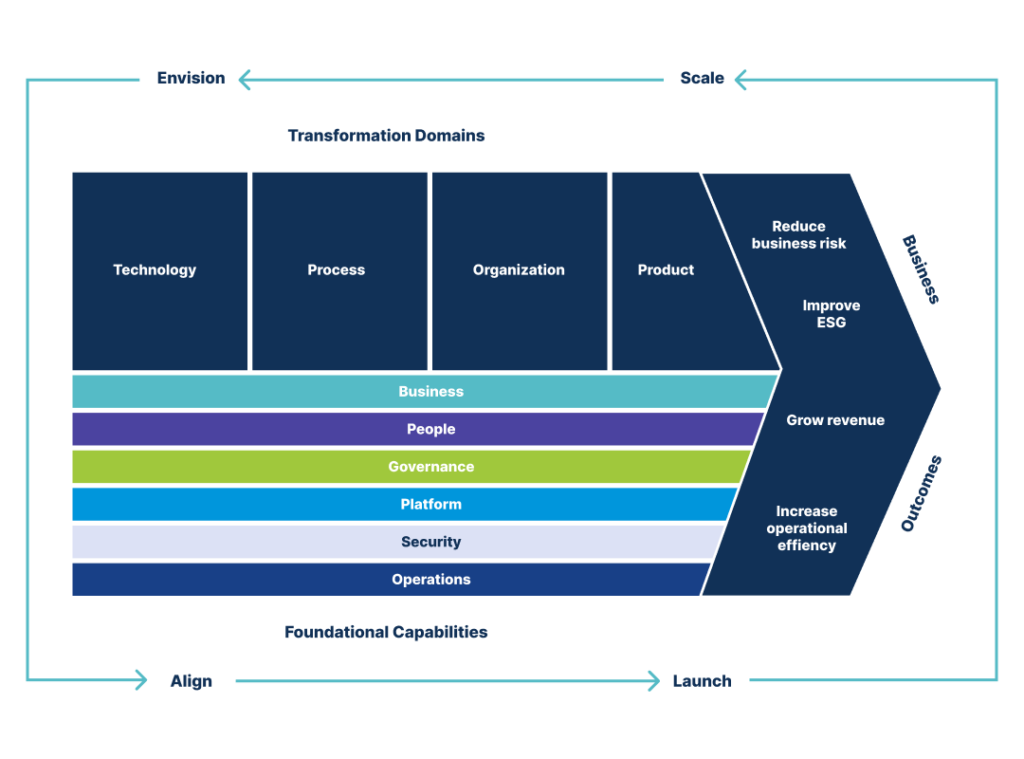Cloud Transformation Value Chain: Extracting Real Benefits
When discussing cloud strategy, many companies need help with understanding their main challenges and planning a structured adoption journey. Additionally, many companies focus only on infrastructure, neglecting several other critical aspects. Even among organizations that have successfully migrated applications to the cloud, unlocking the full benefits of the cloud remains a challenge.
To grasp the advantages of cloud technologies, we need to comprehend the cloud transformation value chain, as outlined in the AWS Cloud Adoption Framework.

To sum up, there are six perspectives that we need to observe to extract value from the cloud:
- Business: Focuses on ensuring that cloud investments accelerate business objectives and digital transformation ambitions. This includes strategy, product, portfolio management, strategic partnerships, innovation management, and data monetization.
- People: One of the most important aspects for a successful journey is people. This is where the connection between technology and business is made by creating a culture of constant evolution. This requires transforming the workforce and leadership, accelerating change, adapting organizational design, and creating fluency in cloud technologies.
- Governance: In this perspective, the emphasis is on orchestrating cloud initiatives while maximizing the benefits for the company and minimizing the risks related to transformation. Topics such as program and project management, cloud financial management, application portfolio, risk management, and data governance are all addressed.
- Platform: Many companies migrating to the cloud only consider the platform perspective, limiting themselves to a few technological aspects without looking at the journey as a whole. Significant topics are platform and data architecture, data engineering, provisioning and orchestration, CI/CD, and cloud-native application development.
- Security: Addressing the security perspective is essential to mitigating risks. Topics to consider are governance, threat detection, data and infrastructure protection, application security, identity and access management, and incident response.
- Operations: Finally, the operations perspective brings together many of the earlier points, ensuring that cloud services are delivered at the level defined by business stakeholders. Some key aspects of this assurance are observability, change management, performance and capacity, application and patch management, and availability and continuity.
Transformation domains
To address the capabilities of these perspectives, we need to act in the 4 domains of transformation:
Technology: This focus is on migrating and modernizing legacy infrastructure. Studies have shown that this modernization generates a 27% reduction in costs per user, a 58% increase in VMs per administrator, a 57% reduction in downtime, and a 34% reduction in security events.
+ Case Study – From legacy systems to cloud success: Priceline’s transformation journey with e-Core
Processes: Focuses on digitizing, automating and optimizing business operations.
Organization: Focuses on rethinking the organizational model, organizing technology and business teams around what generates value for the business, and using agile methodologies to develop faster and become more customer-focused.
Product: The goal is to evolve the business model by creating new products, services, and revenue sources. Studies have shown that the cloud can reduce the time-to-market of applications and new functionalities by 37%.
Finally, we can separate the adoption journey into 4 phases:
Vision: To understand and demonstrate how the cloud will accelerate the expected business results.
Alignment: In this phase, we identify what the company lacks concerning the six perspectives, along with the organization’s dependencies for action.
Launch: At this point, pilot initiatives are put into production to demonstrate increased business benefits.
Scale: The aim is to expand the pilots into production to deliver the business benefits on the desired scale.
Several tools are available to help grasp the current state of companies on a cloud adoption journey—whether they have yet to utilize cloud services or have already migrated workloads—and develop a roadmap for progression.
These tools include the AWS Cloud Readiness Assessment (CART), recommended for all companies; the AWS Migration Readiness Assessment (MRA), particularly suited for larger workloads; the FinOps Maturity Assessment, to ensure best practices in cloud financial management; and the AWS Well-Architected Framework, to ensure efficient design and operation of cloud solutions.
If you are planning to migrate applications to the cloud or if you’ve migrated but are still having challenges, feel free to reach out and schedule a meeting with our specialists to help you with your cloud adoption journey.
LET'S CONNECT
Ready to unlock your team's potential?

e-Core
We combine global expertise with emerging technologies to help companies like yours create innovative digital products, modernize technology platforms, and improve efficiency in digital operations.







